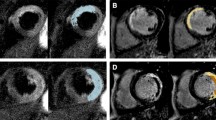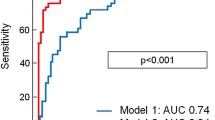Abstract
This study evaluated the prognostic significance of reinfarction location by considering the previous site or type of myocardial infarction (MI) among 1601 patients with a history of previous MI who took part in the International (non-Italian) tPA/STK trial and/or the Israeli GUSTO study population. These patients were accordingly divided and hospital mortality was compared by six location groups as follows: acute inferior with previous inferior (8.1% hospital mortality), acute inferior with previous anterior (12.8%), acute anterior with previous inferior (13.3%), acute anterior with previous anterior (11.1%), acute inferior with previous non-Q-wave MI (7.6%), and acute anterior with previous non-Q-wave MI (11.2%) (p = 0.17 for comparison between the six groups). Hospital mortality tended to increase among patients with an anterior reinfarction compared with those with an inferior one (12.1% vs. 9.5%, p = 0.12). Among patients with a reinfarction at a different ECG location from the previous event, mortality tended to be higher compared with patients with two MIs at the same location (13.1% vs. 9.7%, p = 0.07). Recurrent MI following a previous Q-wave MI did not cause a higher mortality compared with a previous non-Q-wave type of MI (11.5% vs. 9.5%, p = 0.24). Among patients sustaining reinfarction, overall mortality did not differ between STK- and tPA-treated patients (11.0% vs. 11.4%, p = NS). In conclusion, the current study identified trends for higher mortality rates in patients with anterior compared with inferior reinfarction, with remote compared with the same ECG location of the two infarctions but not following a previous non-Q-wave compared with Q-wave MI. However, no particular combination of successive MIs location was significantly associated with a higher risk for hospital mortality.
Similar content being viewed by others
References
Muller JE, Rude RE, Braunwald E, et al. and The Millis Study Group. Myocardial infarct extension: Occurrence, outcome, and risk factors in the multicenter investigation of limitation of infarct size. Ann Intern Med 1988;108:1–6.
Hoit BD, Gilpin EA, Henning H, Maisel AA, Dittrich H, Carlisle J, Ross J Jr. Myocardial infarction in young patients: An analysis by age subsets. Circulation 1986;74:712–721.
Greenberg H, McMaster P, Dwyer EM Jr, and the Multicenter Post-Infarction Research group. Left ventricular dysfunction after acute myocardial infarction: Results of a prospective multicenter study. J Am Coll Cardiol 1984;4:867–874.
Williams WL, Nair RC, Higginson LAJ, Baird MG, Allan K, Beanlands DS. Comparison of clinical and treadmill variables for the prediction of outcome after myocardial infarction. J Am Coll Cardiol 1984;4:477–486.
Madsen EB, Gilpin E, Henning H, et al. Prediction of late mortality after myocardial infarction from variables measured at different times during hospitalization. Am J Cardiol 1984;53:47–54.
Nicod P, Gilpin E, Dittrich H, et al. Short and long term clinical outcome after Q wave and non-Q wave myocardial infarction. Circulation 1989;79:528–548.
Benhorin J, Moss AJ, Oakes D. Prognostic significance of non-fatal myocardial infarction. J Am Coll Cardiol 1990;15:253–258.
Kornowski R, Goldbourt U, Zion M, Mandelzweig L, Kaplinski E, Levo Y, Behar S. Predictors and long term prognostic significance of recurrent infarction in the year after a first myocardial infarction. Am J Cardiol 1993;72:883–888.
Wilcox RG, Olsson CG, Skene AM, Von der Lippe G, Jensen G, Hampton JR. Trial of tissue plasminogen activator for mortality reduction in acute myocardial infarction. Anglo Scandinavian Study of Early Thrombolysis (ASSET). Lancet 1988;2:525–530.
ISIS-2 (Second International Study of Infarct Survival) Collaborative Group. Randomized trial of intravenous streptokinase, oral aspirin, both, or neither among 17,187 cases of suspected acute myocardial infarction. Lancet 1988;2:1–12.
Gruppo Italiano per lo Studio Della Streptochonasi Nell'infarto Myocardico (GISSI). Effectiveness of intravenous thrombolytic treatment in acute myocardial infarction. Lancet 1986;1:396–401.
Simmons ML, Brand M, de Zwaans C, et al. Improved survival after early thrombolysis in acute myocardial infarction. A Randomized Trial by the Interuniversity Cardiology Institute in the Netherlands. Lancet 1985;2:578–582.
Wilcox RG, Von der Lippe G, Olsson CG, Jensen G, Skene AM, Hampton Jr for the Anglo-Scandinavian Study of Early Thrombolysis. Effects of alteplase in acute myocardial infarction: 6-month results from the ASSET study. Lancet 1990;1:1175–1178.
Hillis LD, Forman S, Braunwald E, and The Thrombolysis in Myocardial Infarction (TIMI) Phase II Co-Investigators. Risk stratification before thrombolytic therapy in patients with acute myocardial infarction. J Am Coll Cardiol 1990;16:313–315.
The International Study Group. In hospital mortality and clinical course of 10,891 patients with suspected acute myocardial infarction randomized between alteplase and streptokinase with or without heparin. Lancet 1990;2:71–75.
The GUSTO Investigators. An international randomized trial comparing four thrombolytic strategies for acute myocardial infarction. N Engl J Med 1993;329:673–682.
Van de Werf F, Arnold AER. Intravenous tissue plasminogen activator and size of infarct, left ventricular function, and survival in acute myocardial infarction. Br Med J 1988;297:1374–1379.
The I.S.A.M. Study Group. A prospective trial of intravenous streptokinase in acute myocardial infarction (I.S.A.M.). N Engl J Med 1986;314:1465–1471.
White HD, Norris RM, Brown MA, et al. Effect of intravenous streptokinase on left ventricular function and early survival after acute myocardial infarction. N Engl J Med 1987;317:850–855.
Kennedy JW. Expending the use of thrombolytic therapy for acute myocardial infarction. Ann Intern Med 1990;113:907–908.
Muller DWM, Topol EJ. Selection of patients with acute myocardial infarction for thrombolytic therapy. Ann Intern Med 1990;113:949–960.
Moshkovitz Y, Sclerovsky S, Behar S, Reicher-Reiss H, Kaplinsky E, Golbourt U. Infarct site-related mortality in patients with recurrent myocardial infarction. Am J Med 1993;94:388–394.
Gruppo Italiano per lo Studio Della Sopravvivenza nell'Infarto Miocardico. GISSI-2: A factorial randomised trial of alteplase versus streptokinase and heparin versus no heparin among 12490 patients with acute myocardial infarction. Lancet 1990;336:65–71.
Bebhorin J, Moss AJ, Oakes D, et al. and the Multicenter Diltiazem Post-infarction Research Group. J Am Coll Cardiol 1990;15:1201–1207.
Stone PH, Raabe DS, Jaffe AS, et al. Prognostic significance of location and type of myocardial infarction: Independent adverse outcome associated with anterior location. J Am Coll Cardiol 1988;11:453–463.
The GUSTO Angiographic Investigators. The effect of tissue plasminogen activator, streptokinase, or both on coronary-artery patency, ventricular function, and survival after acute myocardial infarction. N Engl J Med 1993;329:1615–1622.
Mauri F, Gasparini M, Barbonglia L, Santoro E, Franzosi MG, Tognoni G, Rovelli F. Prognostic significance of the extent of myocardial injury in acute myocardial infarction treated by streptokinase (the GISSI trial). Am J Cardiol 1989;63:1291–7.
Fibrinolytic Therapy Trialists' (FTT) Collaborative Group. Indications for fibrinolytic therapy in suspected acute myocardial infarction: Collaborative overview of early mortality and major morbidity results from all randomised trials of more than 1000 patients. Lancet 1994;343:311–322.
Fung AY, Jue J, Henning H, Thompson CR, Davies C, Buller CE. Second infarction: Low prevalence of ST elevation and thrombolytic use. Circulation 1994;90:I-167.
Author information
Authors and Affiliations
Consortia
Rights and permissions
About this article
Cite this article
Kornowski, R., Chetrit, A., Barbash, G. et al. Prognostic importance of previous myocardial infarction in patients receiving thrombolytic therapy for acute infarction. J Thromb Thrombol 3, 391–395 (1996). https://doi.org/10.1007/BF00133083
Received:
Accepted:
Issue Date:
DOI: https://doi.org/10.1007/BF00133083




